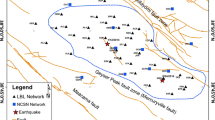Abstract
Natural Time (“NT”) refers to the concept of using small earthquake counts, for example of M > 3 events, to mark the intervals between large earthquakes, for example M > 6 events. The term was first used by Varotsos et al. (2005) and later by Holliday et al. (2006) in their studies of earthquakes. In this paper, we discuss ideas and applications arising from the use of NT to understand earthquake dynamics, in particular by use of the idea of nowcasting. Nowcasting differs from forecasting, in that the goal of nowcasting is to estimate the current state of the system, rather than the probability of a future event. Rather than focus on an individual earthquake faults, we focus on a defined local geographic region surrounding a particular location. This local region is considered to be embedded in a larger regional setting from which we accumulate the relevant statistics. We apply the nowcasting idea to the practical development of methods to estimate the current state of risk for dozens of the world’s seismically exposed megacities, defined as cities having populations of over 1 million persons. We compute a ranking of these cities based on their current nowcast value, and discuss the advantages and limitations of this approach. We note explicitly that the nowcast method is not a model, in that there are no free parameters to be fit to data. Rather, the method is simply a presentation of statistical data, which the user can interpret. Among other results, we find, for example, that the current nowcast ranking of the Los Angeles region is comparable to its ranking just prior to the January 17, 1994 Northridge earthquake.








Similar content being viewed by others
References
ANSS Earthquake catalog search. Accessed April 2, 2017, http://quake.geo.berkeley.edu/anss/catalog-search.html
Bevington, P. R., & Robinson, D. K. (2003). Data reduction and error analysis in the physical sciences. Boston: McGraw-Hill.
Ferguson, C. D., Klein, W., & Rundle, J. B. (1999). Spinodals, scaling, and ergodicity in a model of an earthquake fault with long-range stress transfer. Physical Review E, 60, 1359–1373.
Gutenberg, B., & Richter, C. F. (1942). Earthquake magnitude, energy, intensity and acceleration. Bulletin of the Seismological Society of America, 32, 163–191.
Hamling, I.J. et al. (2017) Complex multifault rupture during the 2016 MW 7.8 Kaikoura earthquake, New Zealand. Science 7194. doi:https://doi.org/10.1126/science.aam
Holliday, J. R., Rundle, J. B., Turcotte, D. L., Klein, W., Tiampo, K. F., & Donnellan, A. (2006). Using earthquake intensities to forecast earthquake occurrence times. Physical Review Letters, 97, 238501.
Holliday, J. R., Graves, W. R., Rundle, J. B., & Turcotte, D. L. (2016). Computing earthquake probabilities on global scales. Pure and Applied Geophysics, 173, 739–748. https://doi.org/10.1007/s00024-014-0951-3. (published online before print 2014).
Hoshen, J., & Kopelman, R. (1976). Percolation and cluster distribution. I. Cluster multiple labeling technique and critical concentration algorithm. Physical Review B, 14, 3428.
Johnston, A. C., & Schweig, E. S. (1996). The enigma of the new madrid earthquakes of 1811–1812. Annual Review of Earth and Planetary Sciences, 24, 339–384.
Klein, W., Gould, H., Gulbahce, N., Rundle, J.B. and Tiampo, K.F. (2007) Structure of fluctuations near mean-field critical points and spinodals and its implication for physical processes. Physical Review E, 75, 031114.
Main, I. G., & Burton, P. W. (1984). Information theory and the earthquake frequency-magnitude distribution. Bulletin of the Seismological Society of America, 74, 1409–1426.
Rundle, J. B., & Klein, W. (1993). Scaling and critical phenomena in a class of slider block cellular automaton models for earthquakes. Journal of Statistical Physics, 72, 405–412.
Rundle, J.B., Turcotte, D.L., Sammis, C., Klein, W. & Shcherbakov, R. (2003). Statistical physics approach to understanding the multiscale dynamics of earthquake fault systems. Rev. Geophys. Space Phys., 41(4), https://doi.org/DOI:10.1029/2003RG000135.
Rundle, J. B., Turcotte, D. L., Donnellan, A., Grant-Ludwig, L., Luginbuhl, M., & Gong, G. (2016). Nowcasting earthquakes. Earth and Space Science, 3, 480–486. https://doi.org/10.1002/2016EA000185.
Scholz, C. H. (1990). The mechanics of earthquakes and faulting. Cambridge: Cambridge University.
Sornette, D., & Knopoff, L. (1997). The paradox of the expected time until the next earthquake. Bulletin of the Seismological Society of America, 87, 789–798.
Stauffer, D., & Aharony, A. (1994). Introduction to percolation theory. London: Taylor and Francis.
Thirumalai, D., & Mountain, R. (1989). Ergodic behavior in supercooled liquids and glasses. Physical Review A, 39, 3563–3574.
Thirumalai, D., & Mountain, R. (1992). Ergodicity and activated dynamics in supercooled liquids. Physical Review A, 45, 3380–3383.
Tiampo, K. F., Rundle, J. B., Klein, W., Martins, J. S. S., & Ferguson, C. D. (2003). Ergodic dynamics in a natural threshold system. Physical Review Letters, 91((1–4)), 238501.
Tiampo, K. F., Rundle, J. B., Klein, W., Martins, J. S. S., & Ferguson, C. D. (2007). Ergodicity in natural fault systems. Physical Review E, 75, 0666107. https://doi.org/10.1103/PhysRevE.75.066107.
Varotsos, P. A., Sarlis, N. V., Tanaka, H. K., & Skordas, E. S. (2005). Some properties of the entropy in natural time. Physical Review E, 71, 032102.
Varotsos, P. A., Sarlis, N. V., & Skordas, E. S. (2011). Natural time analysis: the new view of time. Berlin: Springer.
Wales, D. J. (2004). Energy landscapes: applications to clusters, biomolecules and glasses. Cambridge: Cambridge University. https://doi.org/10.1017/CBO9780511721724. ISBN 978-0-511-72172-4.
Acknowledgements
Research by JBR, ML, and AG were supported under NASA Grant NNX12AM22G to the University of California, Davis.
Author information
Authors and Affiliations
Corresponding author
Rights and permissions
About this article
Cite this article
Rundle, J.B., Luginbuhl, M., Giguere, A. et al. Natural Time, Nowcasting and the Physics of Earthquakes: Estimation of Seismic Risk to Global Megacities. Pure Appl. Geophys. 175, 647–660 (2018). https://doi.org/10.1007/s00024-017-1720-x
Received:
Revised:
Accepted:
Published:
Issue Date:
DOI: https://doi.org/10.1007/s00024-017-1720-x




